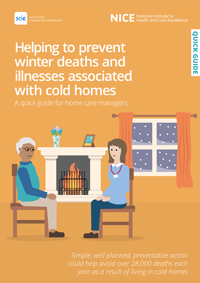A quick guide for home care managers
Simple, well planned, preventative action could help avoid over 28,000 deaths each year as a result of living in cold homes.
For a vulnerable person, living in a cold home increases their chance of serious illness or death. They are at higher risk of a heart attack or stroke, breathing problems, flu, depression and falls.
This effect occurs not just in extreme winter weather but also in moderate conditions and particularly when outdoor temperature drops below 6°C. For those with care needs, being housebound increases both the exposure to an underheated home and the cost of heating it.
Home care managers can take some simple steps to help care staff by having a plan that includes:
Contact details for reporting concerns to local authority health and housing services. This might be a single point of contact with links to agencies that can provide swift support if heating breaks or there are issues with housing conditions, gas, electricity or water supply.
Details of local sources of advice and support that can be shared with vulnerable people (for example, voluntary sector, charities, home improvement services and benefits support).
A training plan for care staff that covers recognising those at risk, considering and assessing vulnerability and how to document and share concerns appropriately.
What is a hard-to-heat home?
Any house can be hard to heat if the cost of heating it to a comfortable and safe temperature is more than the resident can afford. However, houses with the following are the most difficult to keep warm in cold weather:
- broken or draughty windows and doors
- reliance on more traditional heating methods (for example, storage heaters)
- lack of loft space and homes that are part of high-rise blocks.

Identifying those most at risk
Existing health conditions and other personal factors can increase the chance of harm for any vulnerable adult, and particularly those aged over 65. Care staff can help to identify those at risk by having access to care plans and notes, recording their concerns (with consent) and sharing them when needed.
Risk factors:
- heart or breathing conditions
- disabilities affecting the ability to move around to keep warm
- mental health conditions
- low income or debt resulting in fuel poverty
- having attended hospital due to a fall
- living in a hard-to-heat-home
- recent immigrant or asylum-seeker.
Making every contact count
Care staff should not assume that another professional is managing a vulnerable person’s heating needs and instead see each visit as an opportunity to take action:
- At least annually, assess whether a person is vulnerable to the cold.
- Identify what local support is available to make improvements in a hard-to-heat home (for example, heating repair services and building insulation providers) and help the person to access them.
- Give information to vulnerable people about the risks to health of living in a cold home.
- Challenge misconceptions (for example, ‘sleeping in a cold room is good for you’).
- Be aware that people may try to hide difficulties in paying for heating (for example, only putting heating on when expecting a visitor).
- Consider the needs and views of other people in the household.
Having a person-centred conversation
To best assess a person's circumstances and vulnerability to a cold home, care staff should understand the individual's needs, how and when they use their heating (including if financial issues force them to limit its use), how much time is spent at home and any conditions that might be worsened by cold or affect their ability to use their heating.
Being part of a successful discharge home
Returning from hospital to a poorly heated home can lead to new illnesses, worsen existing health conditions and increase the chance of readmission. Home care staff should consider sharing, with the person’s consent, information about vulnerability to a cold home with hospital staff on admission, to help this process.
People who are vulnerable to health problems from living in a cold home should have a plan for how to tackle the problem before they return home. This could include making any necessary home improvements and turning the heating on before returning to the home. This planning should be undertaken at any time throughout the year, not just in the winter months.
When receiving a referral for home care services, ask whether home heating issues have been considered and whether any further action is needed.
Useful links
- Excess winter deaths and illness and the health risks associated with cold homes (NICE guideline)
- Preventing excess winter deaths and illness associated with cold homes (NICE quality standard)
- Cold weather plan for England: protecting health and reducing harm from cold weather (UK Health Security Agency)
- Cold Homes Toolkit (Citizens Advice)
- Home care: delivering personal care and practical support to older people living in their own homes (NICE guideline)
- Helping people living in cold homes: e-learning for frontline practitioners on their local services (UK Health Security Agency)

Download this guide
We've created a copy of this guide that you can print and share:
Helping to prevent winter deaths and illnesses associated with cold homes (PDF)
This content has been co-produced by NICE and the social care institute for excellence (SCIE). It is based on NICE’s guideline on excess winter deaths and illness and the health risks associated with cold homes.